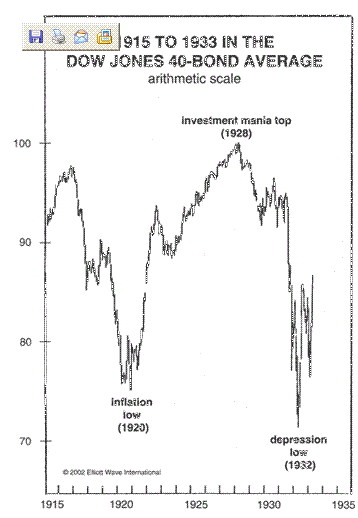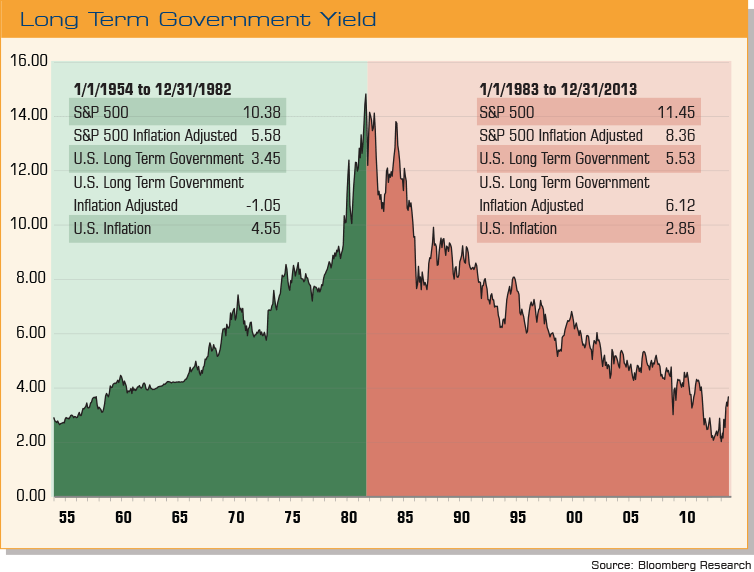Treasury Bond Yields Pointing To a Bear Market For Stocks
Post on: 11 Август, 2015 No Comment

A 1.20 percentage drop in the 10-year Treasury yield foretold bear markets for stocks in 1990, 2000 ad 2007.
Investors continue to pour money into bond funds, even after an 8.5 percent stocks’ gain since July 1.
In the latest battle over who does a better job of forecasting market movements, bonds are sending a strong signal that a bear market for stocks is right around the bend.
Since hitting its most recent high yield of 4.01 percent on April 5, the 10-year Treasury bond has slid more than 1.20 percentage points, a metric that signaled in 1990, 2000 and 2007 that a steep drop in stocks was only two months away, according to research from Gluskin Sheff strategist David Rosenberg.
With the 10-year yield at 2.79 percent in Tuesday trading and the bond market still red-hot despite continued predictions of its demise, the big bear indicator is looming large.
Declines of this magnitude very often presage the onset of bear markets and recessions, Rosenberg says. Typically, equities and then economists are late to the game. What is key to note is that the bond market is the tail that wags the stock market’s dog—it leads.
CNBC.com
Whether the bond market again is foretelling a bear market —a 20 percent drop in stocks from the most recent high—is part of a long-running debate over who does a better job forecasting—stock or bond investors.
Conventional wisdom is that bond investors tend to be more conservative and thus less influenced by fear and greed. That’s cited as the reason by some that the bond market does a better job of getting the economy right.
With all due respect to the stocks guys, the bond guys, when it comes to the economy, tend to sniff things out a little earlier and eventually get things right, says Mike Larson, analyst at Weiss Research. Bond yield levels have given you key insight into what’s going on in the economy. The verdict in my mind is pretty unmistakable.
The concern over what bond market movements portend for the economy come as Wall Street awaits word from the Federal Reserve on what its plans are to juice the economy. The Fed’s Open Market Committee meets Tuesday to discuss rates and possible future quantitative easing measures, though some think the central bank has become less an influence after three years of aggressive policy moves.
In the meantime, economic signs, particularly in employment and consumer and business sentiment. are progressively weakening, indicating that if deflation is not on the horizon, then strong economic growth is unlikely either.
At this pace it would take several years to get back to the level of employment we had before the recession, Larson says. That speaks volumes about what the true underlying condition of the economy is. To me, the stock market is the odd man out.
Indeed, investors seem to be rendering the same verdict, if not in the recent movement of the stock market —where the Standard & Poor’s 500has rallied 8.5 percent since July 1—then at least as far as fund flows are concerned.
Equity fund outflows for the most recent reporting week were $688 million, while bond funds saw inflows of $2.1 billion, continuing a trend that has seen the $2.55 trillion taxable bond market average $7.22 billion in inflows per week for the year, according to Lipper data.

Money market funds and their next-to-zero yields also reflected the desire for safety with just shy of $14 billion of inflows for the week, bringing the cash-on-the-sidelines total to $2.82 trillion, according to the Investment Company Institute.
Those eye-popping totals come on top of the nearly $2 trillion in cash that corporations have on the sidelines.
Why do nonfinancials have a trillion-plus in cash equivalents? There is a reason they do—it’s uncertainty out there, says Bob Andres, CIO and wealth strategist for Merion Wealth Partners in Berwyn, Pa. It’s not that they’re simply borrowing money at a very low cost and putting money on the shelf. They don’t see the opportunity out there. That works against the equity market.
To be sure, the sustained rise in bonds also raises the question of how long the move can last, and whether the driving down of interest rates could be something that ultimately leads to growth.
Conventional wisdom was when (the 10-year yield) broke three (percent) it was somehow bad, says Kevin Ferry, president of Cronus Futures Management in Chicago. We’re much more inclined to say generationally low funding cost for American companies is extremely beneficial in the medium term. The real trick is going to be how much stress the market can stand.
And there’s also the possibility that the bond market is simply wrong and that the economy has only been caught up in a soft patch as some bullish economists have opined.
The extreme pessimism and fear which has been driving bond yields to historic lows is a little bit overdone, says Burt White, chief investment officer at LPL Financial in Boston. The possibility of a double-dip is minimal. The Fed is going to watch this very closely, and if they feel that we are beginning to see a GDP decline quicker than what they would anticipate or if you’re starting to see deflationary pressure creep in, you’ll see them put in quantitative easing techniques to put a floor underneath this.
But if the bond market is right and the economy goes beyond the soft patch and into a swamp, stock investors might wish they had paid closer heed.
I believe the bond market does a much better job of evaluating economic conditions, Andres says. They’re more rational. The equity market is driven more by greed. On top of that, you have Street-side economists always overly optimistic. They love to talk the market up. I think bond guys are smarter.














